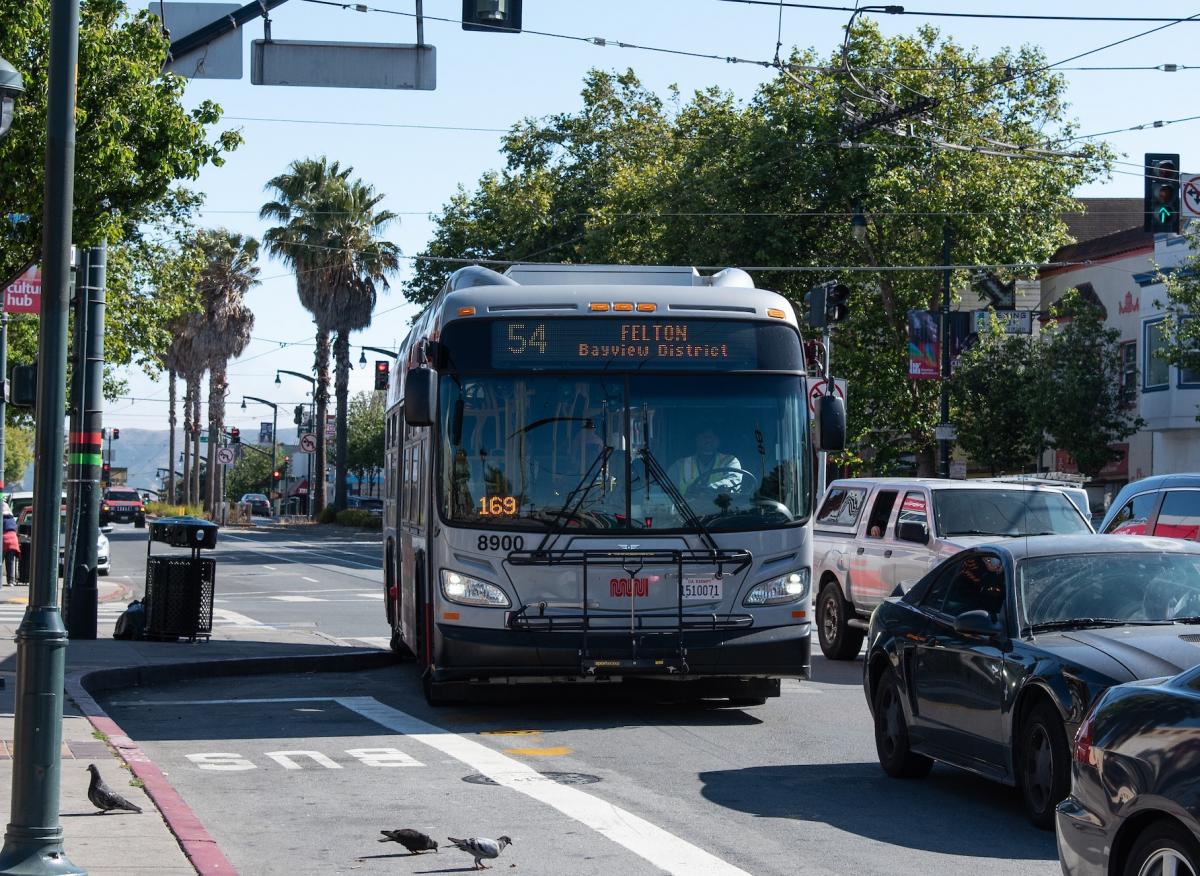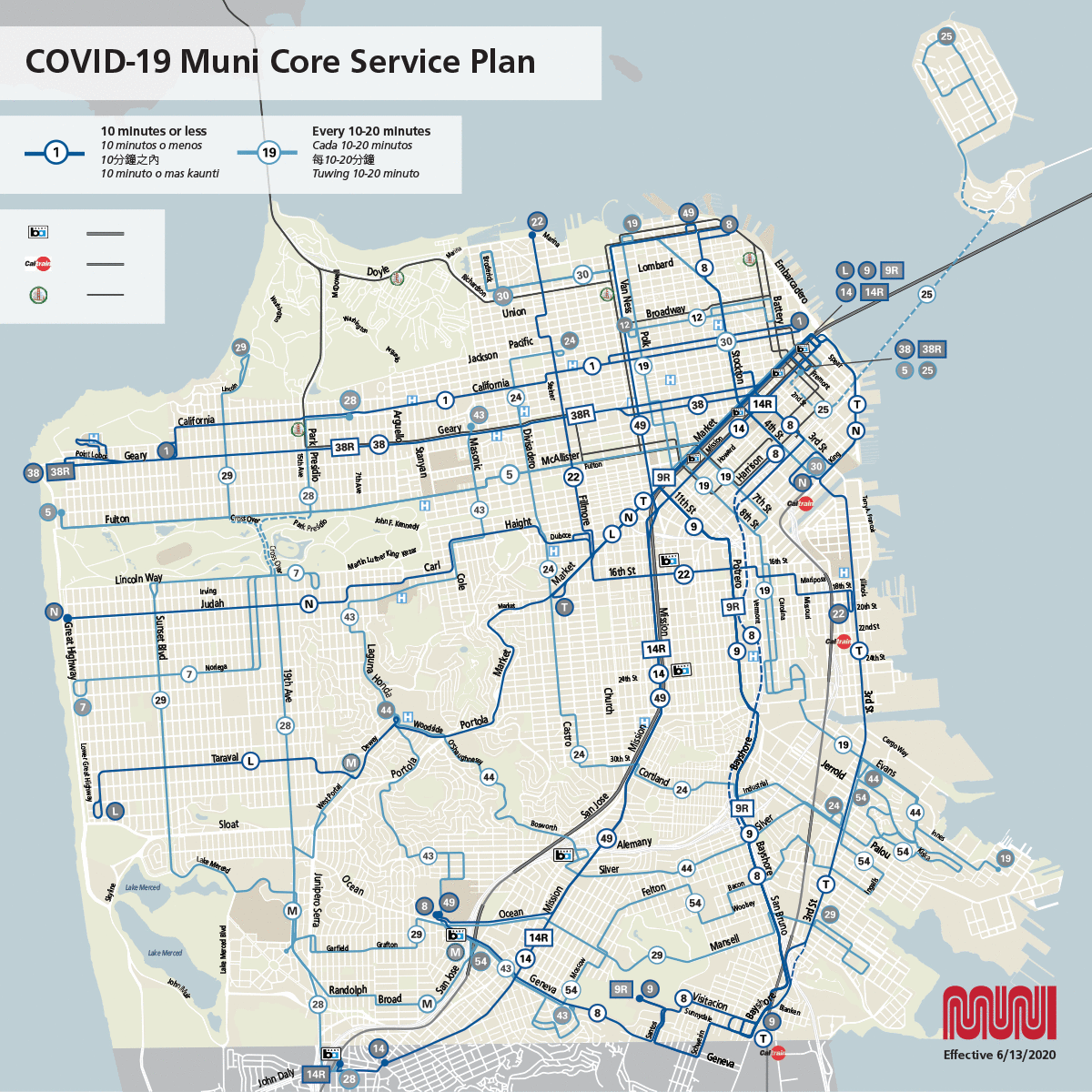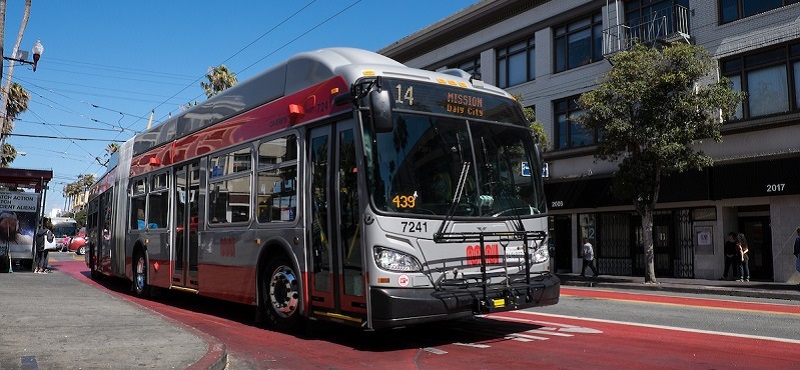Selasa, 21 April 2020
Show HN: Vayu – Interactive, no-code data science notebook https://ift.tt/2RRzcUf
Show HN: Supernotes – a better way to collect your thoughts https://ift.tt/3bpO3NH
Show HN: A spoken language inspired by Tom Bombadil https://ift.tt/2XS8yys
Show HN: My lockdown coding project, Legend of the Pink Dragon (IRC game) https://ift.tt/2RU0SIj
Muni Updates: Restoring Some of Our Service
By Erin McMillan

Since April 8, Muni has been operating a COVID-19 Core Service Plan to support essential trips that cannot be made any other way. With fewer operators, car cleaners and maintenance staff available during the shelter-in-place, Muni service has been significantly reduced. Our initial network of 17 key lines was informed by our data on where ridership is highest, our Muni Equity Strategy to provide transportation for those with the fewest options, locations of essential services like hospitals and groceries, and to provide coverage across the city.
Over the past week and a half, SFMTA has seen a small increase in the number of available key personnel, allowing us to expand our service based on ridership trends and public feedback during the pandemic. On April 25, we will be modifying Muni’s Core Service by adding back some modified routes and increasing the frequency of buses on others. This additional bus service was informed by the same criteria as our initial Core network, along with on-the-ground information from operators, riders, and policy makers.
The service additions will increase coverage across the city and connect to additional essential services. To ensure we’re connecting customers who are making essential trips to health care facilities like hospitals, we’re restoring modified service on the 5 Fulton and 28 19th Avenue lines. Segments of the 12 Folsom/Pacific and 54 Felton are also being restored to ensure customers in Chinatown and southeastern neighborhoods have greater access to essential trip locations.
By adding service on heavily used lines of the Core network, it will also help minimize risks to customers and operators by reducing crowding on buses and increasing riders’ ability to physically distance from others.
Muni still serves approximately 100,000 passengers a day – getting nurses, cooks, custodians, and other essential workers to their jobs. We continue to ask San Franciscans’ help by a) complying with the shelter-in-place directive, b) only making essential trips, and c) using alternatives to Muni for essential trips when possible.
In addition to running Core service, the following Muni routes will start service or be adjusted on Saturday, April 25. Please note differences between weekday and weekend service.
5 Fulton
- Local stops between Salesforce Transit Center and Fulton/6th Avenue
- Frequency: approximately every 10-20 minutes (weekdays and weekends)
- Being added to provide connection to St. Mary’s Hospital
9 San Bruno
- Frequency: approximately 6 minutes (weekdays) and 10 minutes (weekends)
- Being added to reduce crowding on buses, increasing riders’ ability to physically distance
12 Folsom
- Shortened route on Pacific between Van Ness Avenue and Battery
- Frequency: approximately every 20 minutes (weekdays and weekends)
- Being added to provide key connections to grocery stores
28 19th Avenue
- Local stops between Geary Boulevard and Daly City
- Frequency: approximately every 20 minutes (weekdays only, no weekend service)
- Being added to provide healthcare worker access between Daly City BART and UCSF Medical Center, Parnassus; creates additional north-south connectivity on west side
38R Geary Rapid
- Weekend service returning (will supplement existing weekday service)
- Frequency: approximately every 10-20 minutes (weekends)
54 Felton
- Adding shortened route between Newhall/Hudson (Bayview/Hunter’s Point) and Balboa Park
- Frequency: approximately every 20 minutes (weekdays only, no weekend service)
- Being added to provide additional east-west connectivity for southeastern neighborhoods
714 BART Early Bird Shuttle
- Shuttle between Salesforce Transit Center and Daly City
- Frequency: one trip departs Daly City at 4:05 a.m. and second trip departs Salesforce Transit Center at 4:45 a.m. (weekdays only)
- Maintaining a connectivity lifeline for early morning service workers
L Bus
- Increasing frequency to 10 minutes or less (weekdays and weekends)
- Being added to reduce crowding on buses, increasing riders’ ability to physically distance
N Bus
- Increasing frequency to 10 minutes or less (weekends)
- Being added to reduce crowding on buses, increasing riders’ ability to physically distance

This modified Core Service Plan is in support of essential trips that cannot be made in other ways. We are asking all San Franciscans to help us maintain adequate space on buses for social distancing by staying at home except for essential trips. Staying home or walking, biking or driving instead saves a seat on Muni for those that don’t have other options. You may see some of our staff at select bus stops helping reinforce this message to our customers.
Still need to travel on Muni? Be sure to plan extra time for your trip which now may include transfers and a longer walk. Remember your fare is good for two hours across multiple buses. We have also updated our predictions software to better account for the changes in service - read this blog post to find out more.
Essential Trip Card - A New Way to Get Around
We also know that the recent temporary transit changes are hard for many people with disabilities and older adults for whom walking farther to an alternate bus or paying for other transportation isn’t possible. To address this need, the SFMTA launched the Essential Trip Card Program to help older adults and people with disabilities take and pay for essential trips in taxis during this crisis.
The Essential Trip Card Program provides two to three round trips per month at 20% of the cost of a regular cab ride fare. If you are a 65+ years old or person with a disability, you can apply for the Essential Trip Card by calling 311 and mentioning the program or visiting the program page to learn more.
Stay tuned for additional details about these service changes. Visit SFMTA.com/COVID-19 for the latest information or to explore other ways to get around.
Published April 21, 2020 at 03:11AM
https://ift.tt/2RWzmdk
Show HN: Simple Raycasting Engine https://ift.tt/34PcQZ7
Show HN: Sursis, a Network Notebook https://ift.tt/2VoSUJu
A New Way Of Generating Prediction Times
By
The last month has brought about dramatic changes in virtually all aspects of our lives, including how we use our Muni transit system. When we implemented our Core Service Plan that focused our limited resources on 17 lines that were serving the majority of our customers, we also transitioned our service operation from a schedule-based system to a headway or frequency-based system. This means vehicles depart their terminals at regularly timed intervals instead of at specific times. In so doing, we also had to make adjustments on how this information was processed by NextMuni to generate reliable arrival time predictions.

Up until now, if a Muni vehicle departed the terminal before its scheduled departure time, it would register on NextMuni as being on break and would not generate predictions, even though it was on its regular route. When we transitioned to a headway-based system, and as the buses experienced fewer delays on their routes, we started to see a lot of these vehicles depart before their scheduled times. The stopgap solution has been for a small but dedicated team in our Transit division to manually reassign these early departure vehicles within NextMuni, thereby allowing this system to generate predictions. Recently this team has been making about 300 such reassignments per day. This was neither efficient nor sustainable.
Working with our NextMuni vendor, we were able to modify the prediction software to better handle this situation. When generating predictions, the software will now basically disregard any scheduled times and instead rely only on the vehicle’s location.
With this change, arrival time predictions will now only become available once a vehicle has left the terminal. What this means is that if you are waiting at a stop, especially stops near the beginning of the route, you may see “No Prediction Available” when you check either the bus shelter display (should one be available) or NextMuni’s online predictions. This will mean that a vehicle has not yet departed the terminal. In this case, please check either our website or that bus shelter’s display to see the frequency for that particular route. Our website also has a live map which will show the location of each bus on the route, including those at the terminals that are not yet generating predictions. Simply use www.sfmta.com/the letter or number of the Muni route you want to check (For example, www.sfmta.com/22 takes you the live map for the 22 Fillmore.
While this is not ideal, our other option was to make no change and have vehicles operating in service without generating predictions at all. The current changes will make sure most vehicles have predictions most of the time. Another benefit of this change will be that prediction times will now only reflect an actual vehicle that is in service, thus eliminating the dreaded “ghost bus,” which has been the bane of many transit riders.
Please note that our Core Service Plan operates daily from 5 a.m. to 10 p.m. Between 10 p.m. and 5 a.m. our Owl Service Plan is in operation. Frequency times on each of the 10 Owl routes in service will be about 30 minutes. Please visit our Owl Service Plan webpage for further details.
Our team continually reviews the performance of our prediction system and suggests changes when they believe it will result in more accurate information to our riders. In addition to that continuing effort, we are in the process of rolling out a Next Generation Customer Information System as the replacement to NextMuni. When deployed, this new system will allow us to provide more reliable information to our riders, including being able to generate more reliable predictions near the terminals.
For more updates on all SFMTA services during this public health crisis, please visit SFMTA.com/COVID19.
Published April 21, 2020 at 01:20AM
https://ift.tt/2z9IGUq


